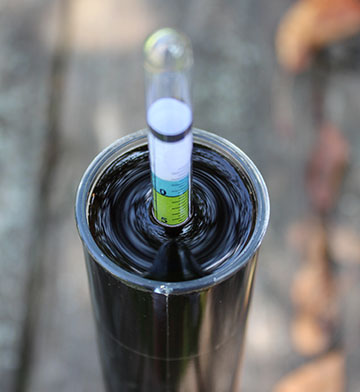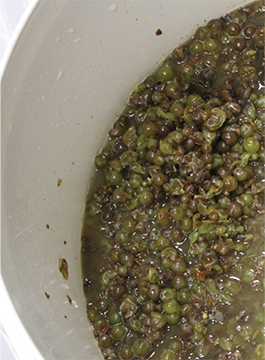
All home winemakers wish — and strive — for fermentations that go smoothly and completely to the desired finish, usually dry wine. When things go wrong, a frequent problem is a stuck or sluggish fermentation. In his classic Knowing and Making Wine, Emile Peynaud refers to these conditions as “fermentation stoppage” and calls that a sign of “stoppage in the growth and the death of yeasts.” There you have it. If there is still fermentable sugar left, but your yeast stops growing or dies, you have a stuck fermentation.
The signs of stuck fermentation depend upon the kind of wine being made. For red wine from fresh or frozen grapes fermenting on the skins, normal fermentation produces a “cap” of floating inflated skins that needs to be punched down or pumped over two or three times a day. At the end of a good fermentation, the cap will come up more slowly, it will be softer, and you can see puddles of wine among the skins when punch-down time comes around. When those conditions prevail, a hydrometer check should show a sugar level of 0.0 °Brix or below. If the remaining gravity is much higher than that, you do not have a finished fermentation but instead a stuck one.
In white wine fermenting in a tank or carboy (or rosé wine or red wine made from juice or concentrate) there is no cap. Instead, you should monitor the fermentation airlock for activity, as well as frequently checking the gravity. If bubbles stop escaping the lock and the hydrometer shows above 0 °Brix, you are stuck.
This article is about restarting a stuck fermentation. If yours seems very sluggish, but you are still seeing activity or a daily drop in Brix, aerating and agitating the wine may get it going again without a full restart protocol as described later. Use a small fan to blow the carbon dioxide off the top of a red must and vigorously splash it as you punch down. If the cap comes up strongly again, you may have successfully invigorated the yeast. In a carboy fermentation, remove the airlock and swirl the carboy or stir with a sanitized stainless steel spoon or rod to try for a similar effect. If those steps do not work, try to figure out the cause of your problem to apply the corrections that I will get into in this article.
Most stuck fermentations occur near the end of the cycle as residual sugar reaches low levels and alcohol rises. Some, however, occur in the form of failure to start (or a very weak start) or midway through the fermentation. There are many possible causes and some of them have relatively simple solutions. Others are more complex, requiring significantly more labor (and supplies) to successfully restart. The following causes are grouped by the required treatments for correction.
Group 1: Temperature Correction
Yeast strains have optimal temperature ranges in which they grow and ferment well. Those ranges are provided by the yeast producer or by your yeast vendor. In fermenting a white wine at a cool temperature, it may be difficult to get started. A temperature around 50 °F (10 °C) may work for a few strains, but some require a temperature as warm as 68 °F (20 °C) to thrive.
At the other end of the scale, in a tank or vat without cooling, a red wine fermentation may get too warm. Peynaud notes the ideal range as between 79 and 86 °F (26 and 30 °C). Temperatures above that range may cause the yeast to slow and stop, possibly to die.
Corrective action: If your fermentation is cold and fails to start (or stops), warm it up a few degrees. If it does not start again on its own, re-inoculate with a fresh pack of yeast. If it is too warm, cool it off. For open tanks, you can freeze plastic water bottles, then place a few in the must and stir. Do not cool or warm rapidly as that may further damage whatever yeast remains viable. Consider re-inoculation. In these cases, it is usually safe to use the same yeast strain as you started with. If fermentation does not resume within about two days, go to the full restart protocol described later.
Group 2: Nutrient Additions
If must or juice is deficient in critical nutrients, fermentation may slow or stop. The most common problem is a shortage of nitrogen in forms useable by the yeast. The most likely need for additional nutrients will come about if the grapes exhibit a poor quality condition such as moldiness. In addition, if you have the opportunity to have testing done by a wine laboratory, you can find out exactly what you need to add. If not, it is best to check with your yeast supplier and determine the likely nutrient demand for the strain you are using. If you have not added nutrients and your fermentation slows, consider this a possibility. The condition is often manifested by a “rotten egg” smell of hydrogen sulfide produced by the stressed yeast.
Corrective action: Adding simple diammonium phosphate at the rate of 1 g/gallon (26 g/hL) may do the trick. For more insurance, use a complete nutrient product like Superfood, Fermaid K, or Fermaid O. Those products are generally applied at 1 or 2 g/gallon (26–52 g/hL). Fermentation should restart within a day and, with a light aeration, off odors should disappear within a few days. If it is not corrected, once again move to full restart.
Group 3: Aeration
Two conditions merit the addition of air to your fermentation. The first is if you happen to have over-sulfited at crush. Adding 50 ppm of sulfur dioxide is common and even 75 ppm should be low enough to allow fermentation to start. If you realize you have added a great deal more than that, aerating the must may clear it up and allow a start. In addition, yeast needs oxygen for growth and reproduction, especially early in the fermentation. If activity seems to be slowing in the first few days, try adding some air and watch for improvement.
Group 4: Adding Water
The most likely condition that will need a water addition is directed at preventing (rather than correcting) a stuck fermentation. If you have a must or juice above about 24 °Brix, check your choice of yeast strain to make sure it will be sufficiently alcohol-tolerant to finish dry. Otherwise, add non-chlorinated (preferably distilled) water to reduce the Brix level to a manageable number before pitching yeast. If you failed to do this with a high-sugar must and alcohol gets too high, you can still add water but it may negatively impact the wine’s flavor and leave it seeming “watered down.” Still, that may be your only choice if alcohol is at or beyond the highest level listed for yeast strains you have access to. A full restart may be needed as well.
Group 5: Full Restart
This is the last resort in any sluggish or stuck fermentation (and you can try it a second time if it fails once). Several conditions can give rise to problems requiring this solution; the most common is high alcohol. Particularly if you started with yeast not capable of high alcohol fermentation but you had high sugar, a restart with a stronger yeast can be very effective. “Wild” or indigenous yeasts are particularly prone to giving up at relatively lower alcohol levels and a restart with a strong commercial yeast strain may finish the job.
Problems other than high alcohol might also make it difficult or impossible for your fermentation to finish. Sometimes a must/wine develops a high population of yeast that carries the so-called “killer factor” that eliminates most other yeasts. If the “killer” strain cannot tolerate the final alcohol level, the fermentation will stick. Similarly, various lactic acid bacteria strains can start growing in a must/wine and produce conditions that inhibit yeast. Finally, yeast growth itself may produce an excess of fatty acids that are toxic and inhibitory to yeast fermentation.
Fortunately, you do not need to know exactly what is wrong for this restart protocol to work. The process is the same for each of the conditions noted here. It is also the procedure to follow if a simpler restart attempt, as described earlier, has failed to take hold. (This version of a full restart is adapted from a Scott Laboratories flyer on the subject.)
Corrective action:
1. Add 1 g/gallon (26 g/hL) of yeast hulls to the stuck wine 24 to 48 hours before your restart attempt.
2. After 24 to 48 hours, rack the wine off of the yeast hulls (they should have removed toxic fatty acids by then).
3. Add another 0.5 g/gallon (13 g/hL) of yeast hulls to the racked wine.
4. Add a complete yeast nutrient such as Fermaid K directly to the stuck wine. If the wine is above 3 °Brix, use 0.5 g/gallon (13 g/hL). If the sugar is between 1 and 3 °Brix, use only 0.25 g/gallon (6.5 g/hL). Below 1 °Brix, add none.
5. In another clean container (the Restart Container), mix 5 percent of your must/wine volume with an equal amount of clean, unchlorinated water. (For instance, if you are restarting 20 gallons, use 20 x 0.05 = 1 gallon or 76 L x 0.05 = 3.8 L of each, water and stuck wine).
6. Measuring for the entire stuck wine volume, weigh out 1.25 g/gallon (32 g/hL) Go-Ferm or other yeast rehydration nutrient. Dissolve that in 20 times its weight of clean, chlorine-free water at 110 °F (43 °C). Mix the solution and cool to 104 °F (40 °C). For our 20-gallon (76-L) example, 20 gallons x 1.25 g/gallon = 25 g (0.76 hL x 32 g/hL = 25 g). Then you want 20 times that much water, so 25 g x 20 = 500 g (or, close enough, 500 mL, which is 17 ounces. But trust me, go metric on this kind of calculation!)
7. Using a vigorous yeast strain that is highly alcohol-tolerant like Uvaferm 43 or EC-1118, weigh out 1 g/gallon (26 g/hL) for the entire restart volume and stir it into the Go-Ferm suspension. Do this slowly, over a period of five minutes, stirring gently to avoid clumping. Let stand 15–20 minutes.
8. Check the temperature of the stuck wine and of the yeast suspension. They should be no more than 18 °F (10 °C) apart. If the temperature difference is greater, mix a small amount of your wine-and-water mixture from your Restart Container in to the suspension and stir again.
9. With successive additions if necessary to adjust the temperature, when the gap is small enough stir the yeast suspension into the Restart Container. Wait 20–30 minutes.
10. Add 10% of your stuck wine volume into the Restart Container. Wait 20–30 minutes.
11. Add 20% of your stuck wine to the Restart Container and wait another 20–30 minutes.
12. Repeat step 11 three more times.
13. Add remaining stuck wine. Increasing the room temperature may also help.
As you can see, this last procedure is much more complicated and time consuming than the simple processes described earlier. If you can avoid a full restart, then you should! That means paying attention to sugar levels and adding water before fermentation if needed, using proper yeast nutrients, and avoiding contamination or the presence of yeast toxins.
Unfortunately, despite our best efforts, it is often nearly impossible to restart a stuck fermentation, particularly at very low Brix. I have been successful on occasion with the “full restart” but have also had failures with it. If you apply it twice without success, you probably need a different plan for your wine.
If it is tolerable as a sweet wine, you may want to stabilize it with sulfite and sorbate and bottle it as-is. Or add more sugar (or grape concentrate) and alcohol to simulate a Port-style wine. If those ideas will not work, you may be able to blend it down to a stable residual sugar level using another dry wine. In the final analysis, you may need to consider it a lesson learned and pour it out.







